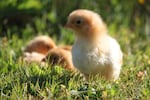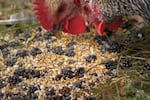It’s quiet at Chad Cottrell’s home outside of Benton City, Washington, but it used to be loud.
In this fenced-in yard, a couple roosters and a baker's dozen of free range chickens scratch.
“At one time we had about 3,500 birds running around this place, chicken houses and everything before we got hit with the avian, and lost it all,” Cottrell said. “That was hard.”
Several years ago, Cottrell ’s domestic ducks mingled with wild ducks, then flew home. The trip landed avian flu in his chicken yard.
He said the toll was immediate. One day his flock looked fine. The next day, hundreds were dead. Other birds staggered like they were drunk. Cottrell still gets a bit misty as he looks out at his near-empty chicken yard.
“Losing that many birds, that much of an investment, you can’t claim it on insurance,” he said. “It was just a loss.”
Bird flu has had a devastating effect on flocks this year across the country, not just in the Northwest. With more than 58 million birds affected, according to the U.S. Department of Agriculture, most Americans have seen egg prices surge – and there may not be much relief on the horizon.

Chicks are selling fast and it's not even spring yet. High egg prices and spotty availability has many starting up their own backyard flocks.
Courtesy of Spring Creek Heritage Farms
Chicka-boom
Some Americans are turning to backyard flocks, and that’s led to a boom in chick sales.
Suzanne Chandler, north of Bellingham, Washington, showed off her chicks in their brooder box on a recent February day. The box is where the small birds arrive right out of the hatcher. They're whisked under a heat lamp and nestle into a pile of their friends.
”Peep, peep, peep, peep, peep!” Chandler exclaimed. “What’s that scary camera thing? They’re so cute!!!”
Chandler hatches more than 100 chicks a week at Flower Feather Farm during the peak season. This year – like many hatcheries and feed stores across the country – she's seen a dramatic increase in orders.
“It’s up 300%from last January,” Chandler said. “January is usually kind of a slow month. People aren’t really interested in it yet. January is still winter and chicks are seen as a spring thing. But man, we hit Boxing Day and the inquiries started coming in.”
Right now, she and other chick breeders have a chick-before-the-egg situation.
“We’re at where every chick is spoken for before the egg has even been laid,” she said.
Many of the families Chandler sells to have never owned chickens before. She’s had people from as far away as Portland, Oregon, and Montana come in person to get chicks.
“That’s part of the joy of what I do, is getting new families kind of educated and mentored. I even rent them the equipment so they don’t have to buy all the brooder equipment,” Chandler said, “so that they can get started having their own chickens, and their own hens, and their own food supply.”
That new-chick-education these days is requiring a heavy dose of reality about biosecurity and avian influenza.
Biosecurity
Another nearby Washington farm, called Spring Creek Heritage, sends chickens across the United States via the mail. Spring Creek owner Matthew Nelson tends to some very rare breeds of chickens.
“With these flocks that we have, some of them have been challenging to get over the years. Like the Hungarian yellows for example,” he said.
He said the yellows are the perfect color to blend in with their surroundings in the field – they’re a hearty, wily bird – able to evade hawks and coyotes. The birds originally came over to America decades ago. But there are not many of them left in the world, according to Nelson.
“They consider that one of their national treasures – the Hungarian yellow and the naked necks,” he explained. “The naked neck has been pretty well preserved but the Hungarian yellows have gone through a couple of bottlenecks in the genetics where it’s gotten pretty thin – and you get down to such a low number of birds it’s hard to replicate that.”
Nelson said he is trying to get 300 females and around 40 males to increase genetic diversity. And that’s even more pressing because of the ongoing influenza wave.
Nelson is strict about the biosecurity at his place. He said he’ll invite very few visitors to his farm. Chicken fan hangs? That happens at a local coffee shop. He says sometimes that’s tough to explain to people who are used to touring farms, but others enjoy the cluck and dagger.
“Some people enjoy it because it’s almost like, ‘Hey I’ll meet you in the parking lot behind McDonald’s and we’ll do the chicken exchange there,’” Nelson said. “A lot of people think that’s fun. As much as I would love to have them over – we can’t because once it’s gone, it’s gone.”

Chicks are in short supply as more people seek to have their own egg layers. But biosecurity concerns with avian influenza have to be top of mind, state veterinarians say.
Spring Creek Heritage Farms
Oregon’s state veterinarian, Ryan Scholz, said people should really consider the risks before turning to backyard flocks as a way to relieve the high egg prices.
“Maybe you should pause one extra time,” Scholz said. “When you think you’re ready to go get those chicks, give yourself one extra day to think through that disease risk.”
With spring migration coming up, more birds will soon be moving around with the virus. And bird flu isn’t the only thing to worry about, Scholz said. Baby chicks often carry salmonella.
“Making sure if you’re handling those chicks; washing your hands really well,” he said. “And supervising small children – both for their safety and for the little chicks as well. I know my daughters have to be supervised very closely – otherwise those chicks end up in a mouth, or getting dropped on their head if you’re not careful.”
Scholz advised new chick owners to keep nest boxes clean, wash eggs in tepid water, and to cook home-laid eggs properly.
Still, Chandler, the chick grower, said nothing beats the cuteness of few-day-old chicks off to their new homes with a loving family. She usually places the baby birds in plastic milk cartons, so children have an easy-grip handle and can see their chicks through the fuzzy plastic.
“They are picking at the shavings that are under them, they are looking at what’s around them,” Chandler said. “If someone puts their hand in and rests it gently on the chicks they will just kinda melt under it. They just feel like it’s mommy’s wing and they’re like ‘Oh mommy, we’ve been looking for you.’ And they’ll just say, ‘peep, peep, peep, peep, peep.’ And it’s so cute.”